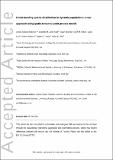Understanding species distribution in dynamic populations : a new approach using spatio‐temporal point process models
Abstract
Understanding and predicting a species’ distribution across a landscape is of central importance in ecology, biogeography and conservation biology. However, it presents daunting challenges when populations are highly dynamic (i.e. increasing or decreasing their ranges), particularly for small populations where information about ecology and life history traits is lacking. Currently, many modelling approaches fail to distinguish whether a site is unoccupied because the available habitat is unsuitable or because a species expanding its range has not arrived at the site yet. As a result, habitat that is indeed suitable may appear unsuitable. To overcome some of these limitations, we use a statistical modelling approach based on spatio‐temporal log‐Gaussian Cox processes. These model the spatial distribution of the species across available habitat and how this distribution changes over time, relative to covariates. In addition, the model explicitly accounts for spatio‐temporal dynamics that are unaccounted for by covariates through a spatio‐temporal stochastic process. We illustrate the approach by predicting the distribution of a recently established population of Eurasian cranes Grus grus in England, UK, and estimate the effect of a reintroduction in the range expansion of the population. Our models show that wetland extent and perimeter‐to‐area ratio have a positive and negative effect, respectively, in crane colonisation probability. Moreover, we find that cranes are more likely to colonise areas near already occupied wetlands and that the colonisation process is progressing at a low rate. Finally, the reintroduction of cranes in SW England can be considered a human‐assisted long‐distance dispersal event that has increased the dispersal potential of the species along a longitudinal axis in S England. Spatio‐temporal log‐Gaussian Cox process models offer an excellent opportunity for the study of species where information on life history traits is lacking, since these are represented through the spatio‐temporal dynamics reflected in the model.
Citation
Soriano-Redondo , A , Jones-Todd , C M , Bearhop , S , Hilton , G M , Lock , L , Stanbury , A , Votier , S C & Illian , J B 2019 , ' Understanding species distribution in dynamic populations : a new approach using spatio‐temporal point process models ' , Ecography , vol. Early View . https://doi.org/10.1111/ecog.03771
Publication
Ecography
Status
Peer reviewed
ISSN
0906-7590Type
Journal article
Description
Funding: EU consolidator’s grant STATEMIG 310820 (SB).Collections
Items in the St Andrews Research Repository are protected by copyright, with all rights reserved, unless otherwise indicated.

